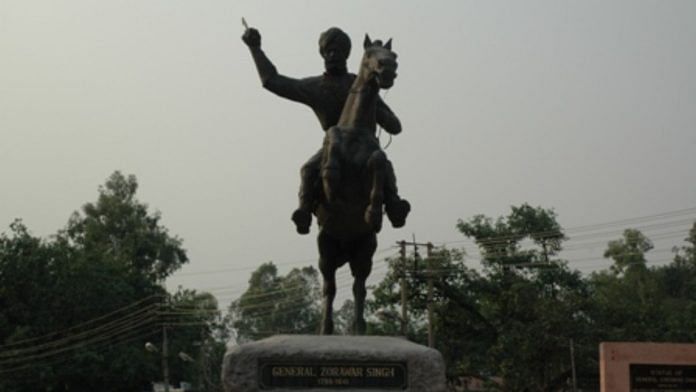It is unlikely anyone can say that the landmark Abdul Rehman vs State of Rajasthan case would have any ramifications in the matter of the recently erected Chhatrapati Shivaji statue on the shores of Pangong Tso in Ladakh. But the 2003 judgment can well travel all the way from the hot Thar Desert to its cold Ladakhi counterpart.
The judgment said that water bodies or catchment areas of any sort cannot be tampered with and have to be restored to their 1947 status. If the local counsellor in Ladakh, who is opposing the installation of the statue, decides to take up the matter legally, this judgment is all he needs.
It is most unlikely that military men have heard of the landmark revenue judgment that had consequences across India in terms of environment, land use changes, and questions of sentimentality vs reality of the soil.
Problems with the statue
But for their general salinity, there is hardly any correlation between Marwar Balia in Rajasthan’s Nagore district and Pangong Tso. Yet there is an indelible connection that has now been made, decades since the dogged Abdul Rehman pursued litigation against his Sarpanch Mohammed Yusuf from court to court. That judgment has, not surprisingly, become a benchmark of sorts for environmental protection, removal of encroachments on catchment areas of water bodies, and the preservation of the 15 August 1947 status quo. District administrators are sworn to uphold this judgment.
So it is well possible that the good intentions of Lt Gen Hitesh Bhalla, General Officer Commanding of the 14 Corps and Colonel of the Regiment Maratha Light Infantry (MLI), could end up weaving a thread that leads from the shores of Pangong Tso Lake to the Nadi in Marwar Balia.
An equestrian statue of Chhatrapati Shivaji has been unveiled on the banks of Pangong Tso, apparently in the unit location of an MLI battalion by the GOC 14 Corps. The Corps Headquarters goes by the tagline, “Fire and Fury”. It is befitting, therefore, that the statue is of Chhatrapati Shivaji, for in pedestrian history, largely of the oral kind, he finds pride of place as the originator of Hindu nationhood.
Local Ladakhi sentiment is, of course, another matter. The Chushul councillor Konchok Stanzin complained that it was done without any local consultations and questioned its relevance to the region. He now just has to read the 2003 judgment.
As a local resident, I must voice my concerns about the Shivaji statue at Pangong. It was erected without local input, and I question its relevance to our unique environment and wildlife. Let's prioritize projects that truly reflect and respect our community and nature. https://t.co/7mpu3yceDp
— Konchok Stanzin (@kstanzinladakh) December 29, 2024
As far as commemorating military icons in Ladakh goes, there are others who could have been considered.
Also read: Gaza, Ukraine being fought on techno-battlefields. Indian military is 3 decades behind
More deserving military heroes
Three soldiers who can safely be credited with changing, or restoring, India’s external boundaries are Gen Zorawar Singh, Maj Ralengnao (Bob) Khathing (retd), and Brig Udai Singh Bhati. Gen Zorawar is the real cartographer of India’s northern boundaries, having heroically won territories against military, climatic, and logistical challenges. Ladakh came under Indian rule after his successful campaign against imperial Qing forces in 1841. Gen Zorawar also won their coveted military banner, Mantalai Standard, which is currently the prized possession of his successors, the 4th Bn Jammu and Kashmir Rifles.
In a daring, unconventional politico-military move, Maj Bob Khathing (retd) secured Tawang for India in 1951. It remains secure today and in perpetuity. The same can be said for areas adjoining Kargil and Drass. They were recaptured from Pakistan in December 1971 under the astonishing leadership of Col Udai Singh Bhati with an equally unconventional force drawn from the Indus Wing of Ladakh Scouts. As a result, the entire area from Kargil to Siachen Glacier remains in secure military hands today.
Little wonder that sentiment in the Jammu region of the erstwhile state demands a statue of Gen Zorawar in Ladakh. As do military veterans who understand the nature of this terrain and Gen Zorawar’s indelible contribution.
When weighed against the military contribution of Chhatrapati Shivaji in Ladakh or Jammu & Kashmir, the scales are tilted heavily in favour of Gen Zorawar. The latter actually changed the map of India as we know it. Despite being largely ignored in Indian history, he remains one of the most extraordinary figures to have led battles.
Manoj Sinha, Lt Gov of Jammu & Kashmir, did unveil a statue of Gen Zorawar Singh at Jammu University, which is an assuring move. But a lot more needs to be done to give the military genius his rightful place in India’s operational pantheon. While the Abdul Rehman vs State of Rajasthan judgment can be evoked at Pangong Tso to restore the water bodies to their original state, local sentiment will continue to demand parity for Gen Zorawer. He sacrificed his life in Tibet, after having won the coveted Mantalai Standard near Mt Kailash.
Manvendra Singh is a BJP leader, Editor-in-Chief of Defence & Security Alert and Chairman, Soldier Welfare Advisory Committee, Rajasthan. He tweets @ManvendraJasol. Views are personal.
(Edited by Prasanna Bachchhav)







Of course, how could someone build a statue of “lowly Maratha” King instead a statue of “great warrior Rajput” General should have been built isn’t that right raja sahab ? While your argument regarding the contribution of Zorawar singh is sound the conspicuous absence of word Maharaj while addressing and Zorawar Singh being a Rajput reeks of some bias or may be it’s one of those “coincidences”
U belong to the ‘peace loving’ lot who don’t find significance for “Shivaji Maharaj” statue anywhere in india.